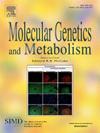神经丝轻链在神经性戈谢病疾病负担和严重程度早期检测和预测中的临床应用
IF 3.5
2区 生物学
Q2 ENDOCRINOLOGY & METABOLISM
引用次数: 0
摘要
新生儿筛查虽然有助于早期诊断,但对正确识别和分型患有神经性戈谢病(nGD)的无症状婴儿提出了挑战。葡萄糖-鞘氨酸(Lyso-GL1)可能在出生时升高,但它不能帮助区分nGD类型。神经丝轻链(NfL)是一种神经元细胞质蛋白,是轴突损伤的标志物,在以神经变性为特征的溶酶体疾病中与脑脊液(CSF)和血液中水平升高有关。在一项前瞻性研究(nct02000310,13 - cfct -07)中,对35例GD患者(年龄6个月至72岁:8 GD1, 7 GD2, 20 GD3)的NfL和Lyso-GL1水平以及其他神经学指标进行了评估。18名患有其他lsd的患者(伴有或不伴有神经退行性变)作为对照。在GD2中,Lyso-GL1明显升高(范围:105-457 ng/mL),所有有神经系统表现的GD2患者NfL均升高。在GD3中,Lyso-GL1水平变化很大,反映了临床异质性。20例GD3患者中有4例NfL升高,所有患者均有临床可识别的神经系统受累。所有GD1患者的NfL水平正常(max: 0.9 (ref:<1.63)), Lyso-GL1接近正常(最大预处理:10)。临床上,听觉脑干反应(ABR)异常与神经退行性变有关。所有GD2患儿ABR均异常,而65%(13/20)的GD3患儿听觉功能正常。联合升高的NfL和Lyso-GL1水平,以及异常的ABR,可以帮助早期识别严重的ngd,甚至在没有特征神经症状的情况下,支持早期诊断和及时临床干预的需要。本文章由计算机程序翻译,如有差异,请以英文原文为准。
The clinical utility of neurofilament light chain for early detection and prediction of disease burden and severity in neuronopathic Gaucher disease
Newborn screening, while enabling early diagnosis, poses challenges to correctly identifying and typing otherwise asymptomatic infants with neuropathic Gaucher disease (nGD). Glucosylsphingosine (Lyso-GL1) may be elevated at birth, but it does not help differentiate between nGD types. Neurofilament light chain (NfL), a neuronal cytoplasmic protein, is a marker for axonal damage and is associated with elevated levels in cerebrospinal fluid (CSF) and blood in lysosomal disorders characterized by neurodegeneration.
In a prospective study (NCT02000310, 13-CFCT-07), NfL and Lyso-GL1 levels were assessed along with other neurological indicators in 35 GD patients (ages 6 months to 72 years: 8 GD1, 7 GD2, 20 GD3). Eighteen patients with other LSDs—with or without neurodegeneration—served as controls. In GD2, Lyso-GL1 was markedly elevated (range: 105–457 ng/mL), and all GD2 patients with neurological manifestations had elevated NfL. In GD3, Lyso-GL1 levels were highly variable, reflecting the clinical heterogeneity. NfL was elevated in 4 of 20 GD3 patients, all of whom had clinically discernable neurological involvement. All GD1 patients had normal NfL levels (max: 0.9 (ref:<1.63)) and near-normal Lyso-GL1 (maximum pretreatment: 10).
Clinically, an abnormal Auditory Brainstem Response (ABR) correlated with neurodegeneration. ABR was abnormal in all GD2 infants tested, while 65 % (13/20) of GD3 patients had normal auditory function. The combination of elevated NfL and Lyso-GL1 levels, along with abnormal ABR, can aid in the early identification of severe nGD—even in the absence of characteristic neurological symptoms—supporting the need for earlier diagnosis and timely clinical intervention.
求助全文
通过发布文献求助,成功后即可免费获取论文全文。
去求助
来源期刊

Molecular genetics and metabolism
生物-生化与分子生物学
CiteScore
5.90
自引率
7.90%
发文量
621
审稿时长
34 days
期刊介绍:
Molecular Genetics and Metabolism contributes to the understanding of the metabolic and molecular basis of disease. This peer reviewed journal publishes articles describing investigations that use the tools of biochemical genetics and molecular genetics for studies of normal and disease states in humans and animal models.
 求助内容:
求助内容: 应助结果提醒方式:
应助结果提醒方式:


